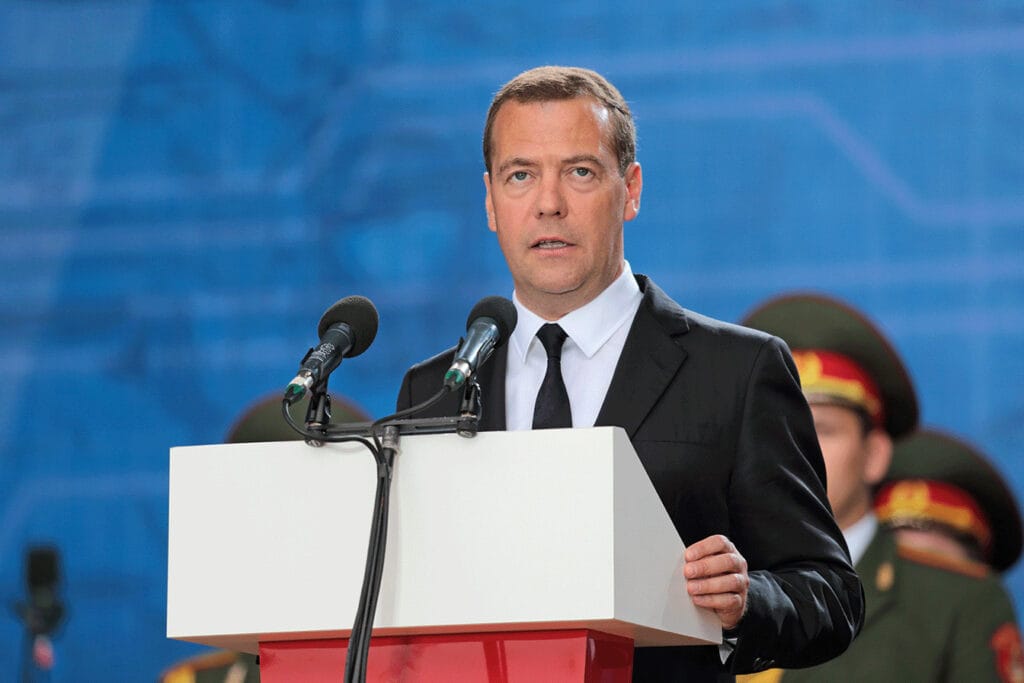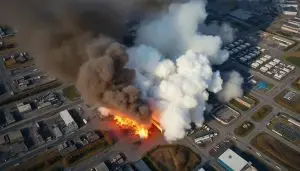Medvedev: Missiles to Ukraine Signal Dire Outcomes For All
Explore Dmitry Medvedev’s stark warning on global security as missiles supplied to Ukraine could lead to military escalation and heightened political tensions.

Medvedev: Missiles to Ukraine Signal Dire Outcomes For All
Medvedev: Missiles to Ukraine Medvedev: Missiles to Ukraine Signal Dire Outcomes. Dmitry Medvedev, the former Russian president, has warned about the dangers of sending U.S. Tomahawk missiles to Ukraine.
He pointed out that Donald Trump’s actions could lead to serious consequences for the United States. Medvedev’s message on Telegram was clear and hinted at a strong response from Russia.
Medvedev said that once a Tomahawk missile is launched, it’s hard to tell if it has a nuclear warhead or not. This makes the situation even more tense and could lead to more military actions. He suggested that Russia might take drastic measures.
Putin has also expressed his concerns about the U.S. sending Tomahawk missiles to Ukraine. He believes it could damage relations between the U.S. and Russia. On the other hand, Ukraine’s president, Volodymyr Zelenskiy, has promised to use any Tomahawks only against military targets.
The U.S. Navy has used Tomahawk missiles in the past, including a 2018 strike. This shows their effectiveness and precision. The debate over long-range weapons is ongoing, affecting both Washington and Europe.
Long-range weapons policy is a significant issue. It can either ease tensions or escalate the situation. The United States is facing tough decisions that could impact the conflict and global security.
Intelligence reports suggest that the situation can change quickly. Russia has hinted that it may take harsher actions if Western support continues to grow. The decisions made now could shape the future of the conflict and global power dynamics.
Medvedev: Missiles to Ukraine Signal Dire Outcomes Key Takeaways
- Medvedev: Missiles to Ukraine Signal Dire Outcomes, Highlights Growing Global Security Risks.
- The ambiguity of Tomahawk missiles raises serious concerns about escalation.
- Trump’s stance on long-range missiles puts pressure on both the U.S. and the world.
- Putin warns that supplying Tomahawks could destroy U.S.-Russia relations.
- Zelenskiy promises to target military sites only, not civilians.
- Reuters’ reporting situates the debate within recent history and current events.
- Policy choices now could either deepen tensions or limit escalation.
Medvedev’s Warning and the Tomahawk Debate
Dmitry Medvedev has made the debate over Tomahawk missiles a key part of the Ukraine conflict and international relations. His words are direct and highlight the growing political tensions. These tensions are causing concern in European capitals and Washington.
Key statement: Potentially dire outcomes for everyone, especially Donald Trump
Medvedev warned of severe consequences for all, and Donald Trump in particular. His statement has intensified a public rivalry. This rivalry has been building through the campaign season and the Ukraine conflict. It has also mixed Tomahawk missiles with politics and strategy.
Claim of indistinguishable nuclear vs. conventional Tomahawks after launch
Medvedev pointed out a critical technical detail. He said that after launch, nuclear and conventional Tomahawks look the same to early warning systems. This uncertainty can increase tensions among nuclear states. For more on how launchers and cruise systems can lead to miscalculations, see this analysis of missile ambiguity and treaty disputes.
Context: Trump’s suggestion of offering long-range Tomahawks to Kyiv
Donald Trump suggested giving long-range Tomahawk missiles to Kyiv if the war doesn’t end. This sparked a heated debate. Medvedev questioned Trump’s intentions, but the signal was clear amid ongoing combat. The discussion is part of a larger conversation about NATO support and warnings on long-range strike red lines.
Kremlin alignment: Putin’s spokesman echoes ambiguity concerns
The Kremlin has echoed Medvedev’s concerns through President Vladimir Putin’s spokesman. This alignment adds weight to Moscow’s stance. It shapes how observers view the next steps in the Ukraine conflict. The ongoing exchange between Trump and Putin is closely watched, with strategic risk at the heart of the matter.
Medvedev: Missiles to Ukraine Signal Dire Outcomes
Recently, Moscow has linked Tomahawk deliveries to a bigger missile crisis. They say it could escalate the war and compromise global security. Now, the phrase medvedev: missiles to ukraine signal dire outcomes is used to talk about Russia and military escalation.
At the core is reach and ambiguity. The Tomahawk missile can travel up to 2,500 km. This means that much of European Russia could fall within its range. Such a distance raises concerns that a single launch could be misinterpreted, thereby increasing the risk to global security.
Escalation risk in the Ukraine conflict and broader international relations
Officials say strategic ambiguity can lead to military escalation. Medvedev believes it could force allies into tough decisions. Kyiv says any Tomahawks would only target military sites, trying to calm concerns.
Analysts also point to new deployments and the collapse of the INF Treaty. This adds to the anxiety. For more on these changes, see this overview of the post-INF environment, which highlights the speed and scale of change.
Range and reach: Tomahawk capability up to 2,500 km impacting European Russia
The Tomahawk’s range of 2,500 km puts Moscow and key bases in danger. This fact is key to the Medvedev argument: the delivery of missiles to Ukraine signals dire outcomes. It illustrates how technical range and political risk are intertwined in Russia, where leaders fear being targeted.
| Factor | Tomahawk (Long-Range) | Policy Signal | Escalation Risk |
|---|---|---|---|
| Range | Up to 2,500 km | Deep-strike capability into European Russia | High due to short warning windows |
| Warhead Ambiguity | Conventional or nuclear variants | Indistinguishable post-launch | Elevated miscalculation risk |
| Command Response | Rapid alert posture | Preemptive countermeasures signaled | Military escalation pressure |
| Regional Impact | Targets across European Russia | Threat perceptions harden | Wider missile crisis narrative |
Putin’s warning: Supplying Tomahawks could destroy U.S.-Russia relations
President Vladimir Putin has warned that giving Tomahawks to Ukraine would ruin U.S.-Russia relations. He links the missile’s range to diplomatic fallout, making global security even more fragile. This ties policy decisions to a broader missile crisis.
Background briefings reveal how missile postures alter the pace and impact of the conflict. For more details, see this analysis of intermediate-range and hypersonic adoption, which maps military escalation risks to readiness and spending.
Medvedev’s Telegram hint: “How should Russia respond? Exactly!”
Medvedev’s hint—“How should Russia respond? Exactly!”—is sharp. It shows uncertainty over intent and payload, leading to military escalation scenarios. Russia sees this as a live missile crisis with global security at risk.
Ukrainian President Volodymyr Zelenskiy has stated that any long-range systems would be used to target only military sites. This pledge aims to ease fears. Yet, the debate—medvedev: missiles to ukraine signal dire outcomes—continues to shape policy and public opinion.
Medvedev: Missiles to Ukraine Signal Dire Outcomes Conclusion
Medvedev’s warning comes at a critical time in world relations. The talk of sending Tomahawks to Kyiv has raised political stakes. Donald Trump has shown openness, while the Kremlin warns of the dangers of misinterpretation.
This uncertainty is a significant risk. A single mistake could spread chaos in the Ukraine conflict and shake global security. It’s not just about the battlefield.
Vladimir Putin has warned that giving long-range missiles to Ukraine could ruin U.S.-Russia relations. This is a big risk in diplomacy. Volodymyr Zelenskiy has promised to use Tomahawks only for military targets, attempting to calm tensions.
But the uncertainty about range and payload keeps tensions high. The missiles’ history shows their power in changing the game. They’ve been used for decades, including a 2018 strike from the USS Laboon.
The conflict is more than just about weapons. It’s also about sanctions, energy, and how each side tests the other. Recent reports on refinery strikes and revenue forecasts in Russia underscore this point. They’re found in analyses like this Russia-Ukraine war briefing.
Ultimately, the combination of capability and uncertainty heightens political tensions. Leaders must carefully consider their next moves. The key is to avoid actions that could lead to unpredictable outcomes in international relations.
The path forward requires caution, clear thinking, and rules that can withstand the strain of a long war. It’s a delicate balance.






